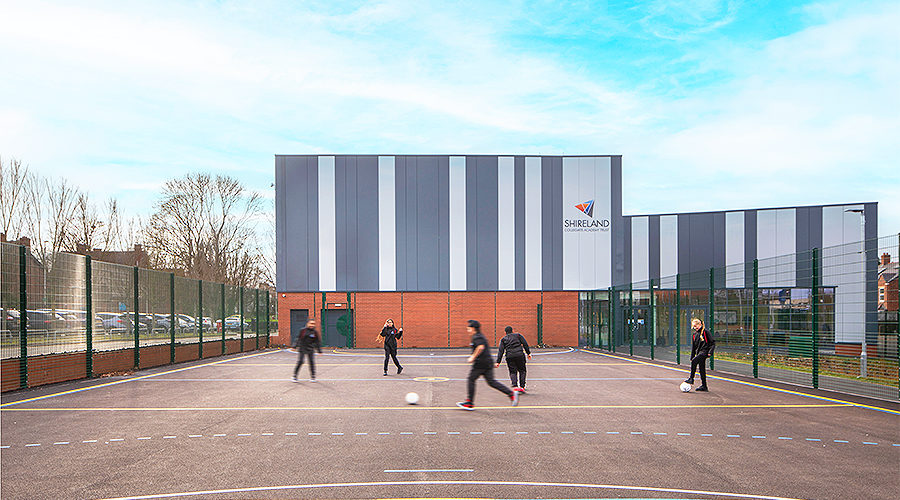ADP Architecture has completed Shireland CBSO Academy, the first free, non-selective state school in Britain to be established in partnership with a professional orchestra.
ADP Architecture
The collaboration between Shireland Collegiate Academy Trust and City of Birmingham Symphony Orchestra (CBSO) marks a radical new approach to music education, innovatively addressing the much-publicised decline in the position of the creative arts in many schools.
The academy’s design is a complete internal remodelling of an existing five-storey office building, providing high-quality facilities to support a world-class music education for 870 students in the West Midlands. The academy accommodates teaching areas for the new secondary school and sixth form, alongside a new sports building on an adjacent road.
The retrofit involved leaving the main structure of the building untouched, including the existing fabric, external cladding, the full-height atrium at the core of the building and the internal stairwells. The open-plan office space surrounding the atrium has been refitted and repurposed, while the car park has been converted into an outdoor social space for students.
Visitors and students enter the academy through a double-height entrance lobby, linked to adjacent open spaces including a box office area. The triple-height performance hall, built within the original atrium space, serves as a centrepiece for the academy, accommodating fixed seating for 300 people. The hall is directly adjacent to the drama studio, which can act as a green room during performances.
The floorspace surrounding the atrium has been converted into teaching spaces and music rooms, and above the performance space is a double-height open-plan library with large overhead rooflights to bring natural light into the space. ADP has also included audio-visual experience rooms that double as immersive spaces for SEN pupils.
The external design of the new sports block is influenced by the existing main building, with red and grey cladding creating a visual connection between the two sites. The building includes a multi-purpose activity studio and a large sports hall with three badminton courts, alongside changing rooms, WC and shower facilities.
ADP Architecture’s design challenges the Department for Education’s baseline model, creating spaces that meet the needs of both a secondary and a music school. Alongside standard secondary school teaching areas, the design incorporates a highly-considered approach to acoustics, wider corridors and the need for larger-than-typical storage facilities to house instruments. In the performance hall, acoustic properties are optimised to match a traditional orchestral space, embracing its use for public musical performances.
Claire Mantle, Schools Sector Director at ADP Architecture, comments: “We are honoured to be part of such a truly inspirational project. The project was driven by a vision for equal opportunities for every child, no matter where they are from and, as a team, we were all excited to be behind delivering this amazing school.
“Our design concept reflected the school’s vision, with performance and learning at the centre of the new school. We located the theatre in the existing central atrium, which unlocked the ground level as the performance floor, housing all the music and drama classrooms.”
David Green, Principal at Shireland CBSO Academy, comments: “We are proud to be providing our students with an education that not only offers academic and musical excellence but also nurtures their creative and personal growth, instilling a lifelong love of learning and the arts.”
Emma Stenning, Chief Executive at CBSO, comments: “With state-provided music education in the UK at a crisis point, and our orchestras acknowledging that something must be done to make our musical forces more representative of the communities they serve, what better way to respond than opening a school that will immerse its pupils in music. We’re delighted that CBSO musicians have a tailored space to provide pupils with masterclasses, mentorship and performances, as well as supporting each young person’s ongoing musical endeavours.”
















